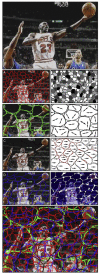The neuronal organization of the retina
- PMID: 23083731
- PMCID: PMC3714606
- DOI: 10.1016/j.neuron.2012.10.002
The neuronal organization of the retina
Abstract
The mammalian retina consists of neurons of >60 distinct types, each playing a specific role in processing visual images. They are arranged in three main stages. The first decomposes the outputs of the rod and cone photoreceptors into ∼12 parallel information streams. The second connects these streams to specific types of retinal ganglion cells. The third combines bipolar and amacrine cell activity to create the diverse encodings of the visual world--roughly 20 of them--that the retina transmits to the brain. New transformations of the visual input continue to be found: at least half of the encodings sent to the brain (ganglion cell response selectivities) remain to be discovered. This diversity of the retina's outputs has yet to be incorporated into our understanding of higher visual function.
Copyright © 2012 Elsevier Inc. All rights reserved.
Figures








References
-
- Amthor FR, Takahashi ES, Oyster CW. Morphologies of rabbit retinal ganglion cells with complex receptive fields. J. Comp. Neurol. 1989;280:97–121. - PubMed
-
- Bieda MC, Copenhagen DR. Inhibition is not required for the production of transient spiking responses from retinal ganglion cells. Vis. Neurosci. 2000;17:243–254. - PubMed
Publication types
MeSH terms
Grants and funding
LinkOut - more resources
Full Text Sources
Other Literature Sources

